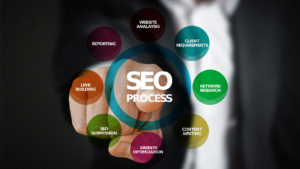SEO For Ecommerce Product Pages | Best Practices

SEO for ecommerce product pages is an important part of a successful online business. Many best practices can be followed to improve the ranking of a product page. By following these tips, you can ensure that your customers find your products easily and that you receive the maximum possible traffic from search engines.
Tips for SEO Ecommerce Product Pages
Fine-Tune Your Keyword SEO Strategy
A well-optimized ecommerce product page can help increase conversion rates and drive more traffic to your store. Here are a few tips to help you fine-tune your keyword SEO strategy:
- Choose the right keywords for your product. Select the right keywords relevant to your product and help you rank higher in search engine results pages (SERPs). You can improve customer engagement and drive traffic to your store by targeting the right keywords.
- Use positive keywords. Search engines reward websites with positive keywords in their titles, descriptions, and tags. This helps users find information about your products faster and makes it easier for them to purchase.
Optimise Titles And Meta Descriptions
Write a click-worthy product title. SEO for ecommerce product pages can be an important part of your online business. Optimising titles and meta descriptions can help increase click-through rates (CTRs) and encourage customers to purchase. Here are some tips for doing just that:
Use keyword-rich titles that accurately reflect the content on your page. This will help boost CTRs and improve your ranking in search engines.
Avoid using generic or vague titles that don’t accurately reflect the content on your page. Ensure to include keywords throughout your title, including the product’s name, the main keyword(s), and the meta description.
Mark Up Product Page Optimization With Structured Data
Best practices for SEO efforts and ecommerce product reviews can vary depending on the business. Still, the markup is a key way to ensure your pages are easy to find and understand for potential buyers.
Structured data, such as labels for attributes like price, colours, and sizes, can help search engines identify specific product information and make it easier for customers to find what they’re looking for.
Add Clear And Helpful FAQs
Do you need to add FAQs to your ecommerce product pages? If so, there are a few things you should keep in mind.
- First, make sure your FAQs are clear and helpful. People will skim over them if they’re unclear or the answers are irrelevant to their questions.
- Second, ensure all your FAQs are linked from the product page itself. This way, people can quickly and easily find the information they’re looking for.
- Finally, make sure you answer all of your customers’ questions! If you can’t answer a question, find someone who can and add their answer to your FAQs.
Use High-Quality Video and Imagery
When creating an ecommerce product page, it’s important to use high-quality video and imagery to draw in a potential customer. Here are a few tips for doing just that:
- Use video to show off the product review in action. This can help demonstrate how the product schema works or for showing off unique features.
- Make use of images that are relevant to the product and its category. If your product is a clothing item, include pictures of people wearing your products.
- Select images that are high quality and will resonate with your target audience. Ensure they’re large enough to be easily seen and don’t contain inappropriate content.

Things You Shouldn’t Do For Your Ecommerce Product Pages
Kill Your Seasonal Pages Once Peak Is Past
If you’re selling seasonal products, it’s important to consider the point in the calendar year when your product’s popularity will be at its lowest. Changing the design of your product pages, removing seasonal content, or disabling search engine optimization (SEO) can kill your traffic and prevent you from making any sales during this time. Instead, wait until peak season has passed and your traffic naturally decreases before making changes to your related product pages.
Use Automated Optimization
Don’t use automated optimisation techniques that Google does not approve. These can include things like hidden text and sneaky redirects. Make sure all your product images have high-quality images showing the product in its best light. This will help encourage buyers to make a purchase. Avoid spammy or intrusive ads on your product attributes- they’ll only turn away potential buyers.
Charge The Wrong Price
Don’t charge the wrong price for your products. This can lead to lost sales and decreased brand visibility. Ensure that your price is relevant to the product attributes and its features. Display an accurate inventory of your products so that buyers can see how much stock you have available. Make sure your images are high quality and meet the standards of your niche market.
Duplicate Content for Similar Product Pages
Don’t duplicate content on your product pages. This means that if the same information is available on other pages in your store, don’t include it on your product page. This includes images, descriptions, and pricing information. If someone is looking for information about a specific product, they’ll likely go to the product’s page rather than through all the other unique content on your site.
Copy Description from Manufacturer or Popular Sites
When creating your ecommerce product page seo, it’s important to remember that you should never copy the description or images from other websites. This can lead to confusing customers and lower sales. Instead, create descriptions and images that reflect the product you are selling. Additionally, include keywords in your titles and descriptions so potential customers can find your products when searching online.

Conclusion
Improving your SEO effort will help you rank higher in search engine results pages (SERPs), giving your customers a better chance of finding and buying your products. A good SEO tool can help you attract more organic traffic to your website from people looking for specific products or services. This “natural” traffic is much more valuable than any traffic you receive via paid advertising.
High-quality SEO tools can help increase the visibility of your product pages on social media websites such as Facebook and Twitter. This increased visibility can lead to new customers and even word-of-mouth marketing recommendations.
Was this article helpful? Let us know in the comments.
FAQ
What is the most important on-page SEO factor?
Many factors go into on-page SEO, but the most important is ensuring your website’s high-quality content.
The first step in ensuring unique content is creating a well-defined editorial calendar. This will help you plan your topics and ensure each article is written with a purpose. Another key factor is using keyword research to find relevant keywords and incorporating them into your website’s titles, tags, and other metadata elements.
Are our product tags good for SEO?
While it is difficult to definitively say whether or not product tags are beneficial for ranking, there are a few reasons why they could be. For one, product names can act as keyword research tools, helping you identify which keywords to target when writing your content. Additionally, product tags help users find your content more easily by allowing them to filter out irrelevant results.
However, it’s important to remember that product tag optimisation should only be done if your brand’s goals align with search engines’ goals. If your objective is to attract more traffic from potential customers rather than rank higher in search engine results pages (SERPs), then using product tags may not be your best strategy.
How do I create SEO for my product?
To create effective SEO for your product description, start by understanding the basics of search engine optimization (SEO). Search engine algorithms work based on many factors, notably how well your website optimises for keywords. By targeting the right keywords and crafting your content to benefit search engines, you can increase traffic to your site and improve your ranking. Creating an effective marketing strategy can also help boost traffic to your site.
You can increase sales by developing strong brand awareness and compelling copy targeting buyers. Ultimately, it’s important to have a comprehensive approach when optimising your product description for SEO; consider all angles when designing and executing your campaign.





